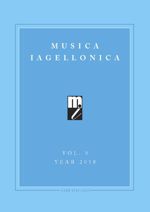In sí gran martire… A tonal experiment in Luigi Rossi’s Il Palazzo incantato d’Atlante
In sí gran martire… A tonal experiment in Luigi Rossi’s Il Palazzo incantato d’Atlante
Author(s): Zygmunt M. SzweykowskiSubject(s): Music
Published by: Musica Iagellonica Sp. z o.o.
Keywords: Luigi Rossi; Il Palazzo incantato d’Atlante; lament of Alceste; tonal experiment
Summary/Abstract: The subject of the article is Scene 6 from Act III of Luigi Rossi’s musical dramaIl Palazzo incantato d’Atlante (1642) to a libretto by Giulio Rospigliosi. This particularscene is worthy of attention, because the composer has given it a thoroughly uniquemusical setting as compared to early Italian drammi per musica. It not only featuresmore than one key signature sign — two sharps appear at the clefs — but also fivesharps as accidentals in the music itself, thus using rare pitch material for late sixteenthand early seventeenth century output. The composer resorts to transposing thea-aeolianmode by a whole tone upwards, thus emphasizing b as finalis (not includedin the canon of finales, even in the dodecachordal system), and likely purposefullychoosing a rare key in late Renaissance and early Baroque music, one that carriesa pointedly expressive sense. He simultaneously enriched — with such ‘sharpened key’as background — the monologue’s pitch material, radically mining the tendency to thedurus tonal sphere. In tandem, the phenomena appear here for the first time on theterrain of Italian dramma per musica. The reason for introducing this compositionalsolution was the content of Giulio Rospigliosi’s libretto, laden with nearly harsh wordsrelating Lidia’s cruelty and Alceste’s suffering. This text also demanded an extraordinarymusical setting.
Journal: Musica Iagellonica
- Issue Year: 9/2018
- Issue No: 1
- Page Range: 71-80
- Page Count: 9
- Language: English

